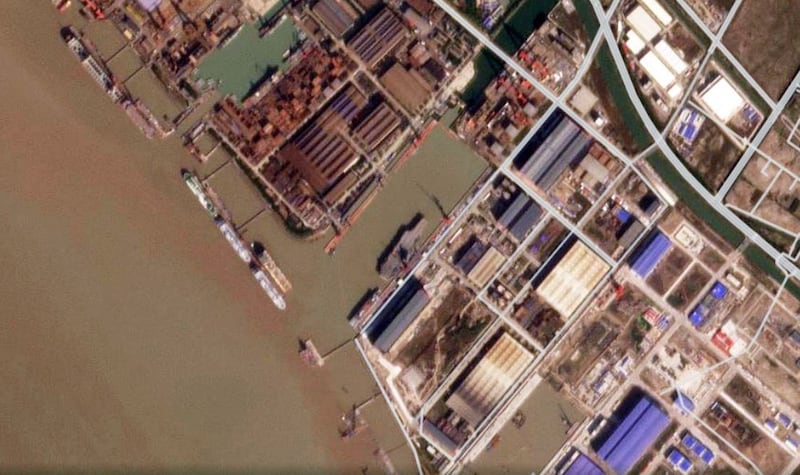Chinese developers are believed to have started testing electromagnetic catapults on China’s third aircraft carrier, which analysts say is an important milestone in the country’s naval ship construction.
The catapults will be used for launching airplanes from the carrier, named Fujian after the Chinese province closest to Taiwan. The Fujian features a so-called Catapult Assisted Take-Off Barrier Arrested Recovery, or CATOBAR, system that is much more advanced than the first two carriers.
A video clip, said to be filmed from an overflying airplane and shared first on China's Weibo microblogging website, shows what appeared to be a test vehicle being dropped from a catapult position on the Fujian aircraft carrier into the water.
The apparently successful test took place on Sunday.
A satellite image from Nov. 26 provided by the U.S. Earth imaging company Planet Labs shows the Chinese aircraft carrier sitting at its berth at the Jiangnan Shipyard in Shanghai. A crane that may be used during the test launch was visible at the front of the ship.
“This is one of the most eagerly awaited milestones besides the first sea trial,” said Andreas Rupprecht, a well-known Chinese military blogger.
"Suffice to say, an important step towards getting the ship operational," wrote another analyst, Alex Luck, on the social media platform X, formerly known as Twitter.
The 80,000-ton Fujian – also called Type 003 – is China’s third aircraft carrier, built with a fully indigenous design. It is also the first People’s Liberation Army (PLA) carrier equipped with electromagnetic catapults and arresting devices similar to the ones on U.S. aircraft carriers.
The PLA’s first aircraft carriers – Liaoning and Shandong – use a less advanced ski jump-style launch system but the Fujian’s CATOBAR will help launch a bigger variety of aircraft faster and with more ammunition.
China’s maritime ambition
Currently, only France and the United States are members of the CATOBAR club, and China, having never operated a CATOBAR carrier before, is starting from the ground up in developing one, according to Robert Farley, a senior lecturer at the Patterson School of Diplomacy and International Commerce, University of Kentucky.
“Fujian carries electromagnetic catapults (EMALS), which are a complicated new technology,” said Farley. “I don't know if we can generate a clear estimate on the length of catapult testing because it's uncharted territory.”
Aircraft carriers represent China's maritime ambitions and the carrier fleet may be expanded to five ships in the next 10 years, according to a report by the Center for Strategic and Budgetary Assessments (CSBA), an independent U.S. think tank specializing in defense policy, planning and budgets.
The PLA developed Liaoning, its first aircraft carrier, from a Soviet-built ship and commissioned it in 2012. The second carrier and the first domestically-built – Shandong – was commissioned seven years later.
The construction of the Fujian aircraft carrier began during the 2010s and the ship was launched in June 2022. It is currently undergoing mooring trials at the shipyard before being put on sea trials.
Compared to the Liaoning and Shandong, the Fujian with an 80,000-ton displacement is not only much bigger but also far more technologically advanced.
Still a long way
Although Fujian looks to be an impressive ship, larger than any carrier in the world other than the U.S. supercarriers, Farley believes the Chinese are still significantly behind in several areas.
The U.S. Navy has 11 aircraft carriers, most of them of the large “supercarrier” category, which are much more advanced and powerful.
“As a ship, Fujian is only about 80% as large as existing U.S. carriers, and is conventionally propelled rather than nuclear, which makes a big difference for range, endurance, and carrying capacity,” he said.

It will take a while for the ship to become fully operational as the Fujian has yet to begin sea trials.
“For the first ship of a new class, the entire process of trials can often take a year or more. Her predecessor, Shandong, took 19 months from completion to commissioning and was of a far less advanced design,” the analyst told Radio Free Asia.
“After sea trials are done the PLA Navy will need to begin work on carrier group training, which will require very detailed procedures of launch and landing to be worked out,” he added.
“The PLA has historically been careful and deliberate with training for its carrier operations and I would expect them to continue to do so.”
Military experts say the Fujian may be commissioned by 2025 but its capacity will be gradually built up in the following years.
According to Farley, “training up to U.S. standards will take years, if not decades.”
The PLA has the largest navy in the world by number with an overall battle force of over 370 ships and submarines, compared to the U.S.'s 293, according to the Pentagon.
Edited by Mike Firn and Taejun Kang.
